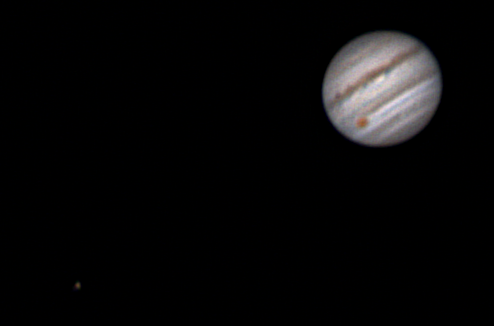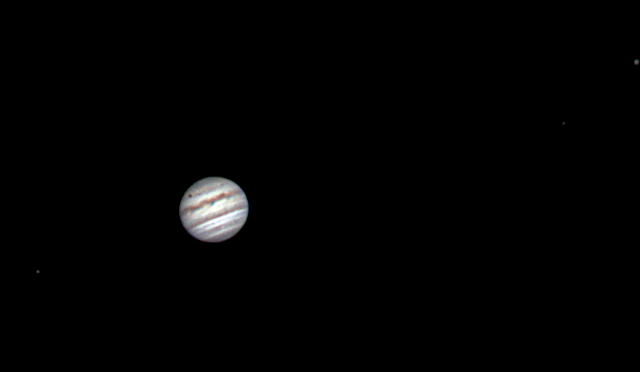

I have joined The Doncaster Astronomical Society and they have a superb observatory including a 14-inch Meade LX200 and an Orion Optics ODK12 telescope. I have started using the LX200 as a planetary-imaging 'scope. Its longer focal length of 3556 mm makes it a more powerful imager than my 10-inch. The first picture below is my first attempt at Jupiter.
 |
Jupiter is very low in the skies this year and this picture was taken not long after it rose when Jupiter was at an altitude of only 16°. I had forgotten to take the adaptor that would allow me to use my atmospheric dispersion corrector but RegiStax has done a good job realigning the colours. The satellite is Io; Europa was occulted and Ganymede and Callisto were just out of the frame to the lower left. Date and Time: 19 April 2018 23:46 UT Telescope: 14-inch LX200 Camera: DFK 21AF04 Capture: IC Capture, 1789 frames, 1/60", gain 737 Processing: RegiStax 5, 238 frames stacked, colours realigned automatically, Gaussian wavelets Scheme 10 |
|
 |
On 6 June there was a transit of Europa. This sequence of six pictures shows the progress of the transit from soon after the shadow transit began until about half an hour before it finished. The times are given below each image. Europa is difficult to see at 11:08 but is clearly visible at 22:32 just before the end of its transit. The Great Red Spot is just coming into view at 22:40 as Europa just clears the planet. By 23:40 the GRS had become clearly visible. 10-inch LX200 at prime focus. DFK 21AF04 camera, 1/108 sec exposure, gain 850, 1800 frames each. Processed in Registax5, ~200 frames stacked, Gaussian wavelets Scheme 10 |
|

|
And here is a wider image showing the other three Galilean satellites. Move your mouse pointer over the image to see them identified. The dark spot on the north-west limb of Jupiter is the shadow of Europa. Europa itself is not clearly visible but is about where indicated by the red arrow. The picture is a composite of two images and has been reduced to fit on the page. Telescope: 10-inch LX200 Camera: DFK 21AF04 Exposure: 1/108 sec Gain: 847 Processed in Registax5, 140-267 frames stacked, Wavelets 1-2=10, gamma 1.6 |
|